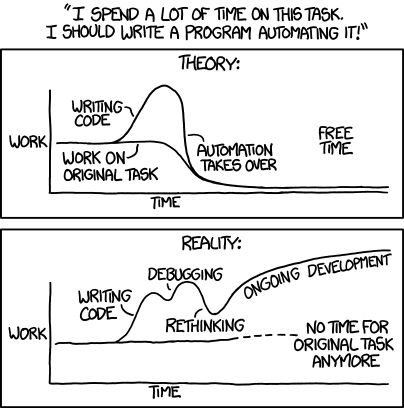With agentic coding assistants like VS Code's agent mode, Cursor, and my personal favorite Claude code, building niche tools is faster and easier than ever before. Writing throwaway software used to be a luxury. It still happened of course, I'm not saying it's ever been impossible, but the process was often more complicated than just doing the task manually. But agents have changed the calculation, what used to take a week to build now takes hours. Costs to maintain such software has gone down a ton. I'm confident out of all of the software that will be 100% maintained by agents, over 50% of it will be this kind of niche software. The XKCD comic below is a greate example of the old way of thinking about throwaway scripts and software.

Nowadays, the debugging, rethinking, and ongoing development tasks of these tools can be 100% delegated to your agent. It's still not quite 100% automated yet, but the calculation has definitely changed.
This rapid development cycle for developer experience utilities is the most underrated way to increase productivity with agents. If there's a manual interaction with a web service that has an API, build a command line tool for your agent to use. The biggest boost from agents versus chat-only LLMs is, well, their agency. The ability for an agent to call tools and interpret the results are what makes them so useful.
Take this example from
Anthropic about the already popular gh command:
Claude knows how to use the gh CLI to interact with GitHub for creating issues, opening pull requests, reading comments, and more. Without gh installed, Claude can still use the GitHub API or MCP server (if you have it installed).
You should be thinking about how to build the gh for your team or service. Building niche tools for
your agents will set you apart from those who just copy and paste code in and out of cursor.
The legacy workflow
Before agents, developers could mount their code in a docker volume that would update regularly. The flow was:
- Write code
- Import error
- Fix code
- Trigger dag
- Task failed
- Fix code
- Clear tasks
- Finally watch logs succeed
This iteration loop was completely broken. Imagine a random slack huddle pop up throwing you out of the zone in the middle of this loop. Experienced developers have consistently noted that context switching is the number one killer of your productivity. The context switch between your agent and your system that you're working on is just as expensive.
Practical example with afcli
For my data engineering work, I built afcli to
streamline Airflow development. The key feature: --host functionality that points directly to a
running Airflow instance, eliminating the need to find docker container IDs and run complex exec commands.
In your CLAUDE.md, add:
When building with airflow, check the dag and task level statuses with `afcli`.
Use `afcli` for fetching logs and to validate your changes.
After making a change, run `afcli` to kick off the dag or task that you're working on and iterate until every task succeeds.
Run `afcli --help` to understand common usage patterns and specific CLI options.
Giving your agent instructions on how to iterate faster unlocks a tight loop that will let you turn features around faster than ever.
Next Steps
- Audit your workflow for repetitive API interactions
- Pick one service and build a simple CLI wrapper if it doesn't exist yet
- Add it to your agent's toolkit (CLAUDE.md or equivalent)
- Iterate based on what your agent struggles with
Try it yourself: pip install afcli for Airflow development, or build your own
tool for your specific needs.
This post was written by John from Ouachita Labs. If you have a question about how to work better with AI, please reach out to me at john@ouachitalabs.com.